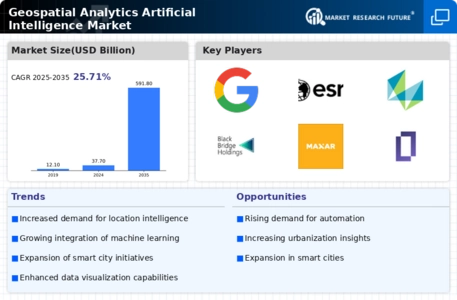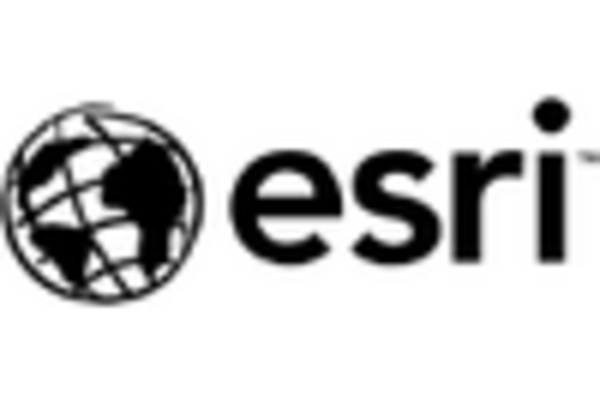Government Initiatives and Investments
Government initiatives and investments in geospatial infrastructure are emerging as a crucial driver for the Geospatial Analytics Artificial Intelligence Market. Many governments are recognizing the importance of geospatial data for urban planning, disaster management, and environmental monitoring. As a result, they are allocating significant resources to develop and enhance geospatial capabilities. For instance, various countries have launched national geospatial strategies aimed at improving data accessibility and fostering innovation in the sector. This trend is likely to stimulate market growth, as public sector investments create opportunities for private enterprises to develop AI-driven geospatial solutions. The collaboration between government entities and private companies may further accelerate advancements in the field.
Rising Demand for Location-Based Services
The increasing reliance on location-based services across various sectors appears to be a primary driver for the Geospatial Analytics Artificial Intelligence Market. Businesses are leveraging geospatial data to enhance customer experiences, optimize logistics, and improve decision-making processes. According to recent estimates, the market for location-based services is projected to reach substantial figures, indicating a robust growth trajectory. This trend is particularly evident in retail, transportation, and urban planning, where precise location data can lead to significant operational efficiencies. As organizations continue to recognize the value of integrating geospatial analytics with artificial intelligence, the demand for innovative solutions is likely to escalate, further propelling the market forward.
Emergence of Smart Cities and Urbanization
The emergence of smart cities and rapid urbanization are driving forces behind the Geospatial Analytics Artificial Intelligence Market. As urban areas expand, the need for efficient resource management and infrastructure planning becomes increasingly critical. Geospatial analytics, powered by artificial intelligence, offers solutions for traffic management, energy consumption, and public safety. Market data suggests that investments in smart city initiatives are on the rise, with cities adopting advanced technologies to improve livability and sustainability. This trend is likely to create a demand for innovative geospatial solutions that can address the complexities of urban environments. The interplay between urbanization and geospatial analytics is expected to shape the future of city planning and management.
Advancements in Satellite and Sensor Technologies
Technological advancements in satellite and sensor technologies are significantly influencing the Geospatial Analytics Artificial Intelligence Market. Enhanced satellite imagery and sophisticated sensors provide high-resolution data that can be analyzed using AI algorithms, leading to more accurate insights. The proliferation of Internet of Things (IoT) devices has also contributed to this trend, as they generate vast amounts of geospatial data that can be harnessed for various applications. Market data suggests that the integration of these technologies is expected to drive substantial growth in the sector, as organizations seek to utilize real-time data for improved operational efficiency and strategic planning. This synergy between advanced technologies and AI is likely to redefine the landscape of geospatial analytics.
Growing Importance of Data-Driven Decision Making
The growing importance of data-driven decision making across industries is likely to propel the Geospatial Analytics Artificial Intelligence Market. Organizations are increasingly recognizing that leveraging data analytics, particularly geospatial data, can lead to more informed and strategic decisions. This shift is evident in sectors such as agriculture, where precision farming techniques utilize geospatial analytics to optimize crop yields. Market Research Future indicates that the demand for data-driven insights is expected to rise, as businesses seek to enhance operational efficiency and gain competitive advantages. The integration of AI with geospatial analytics enables organizations to process vast datasets quickly, providing timely insights that can influence critical business decisions.

















Leave a Comment